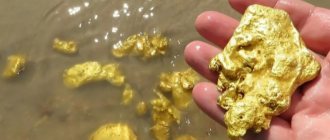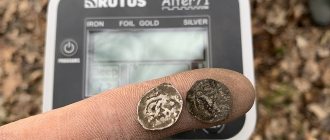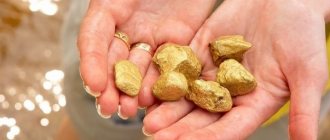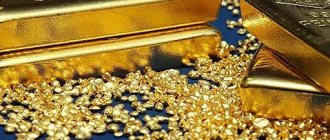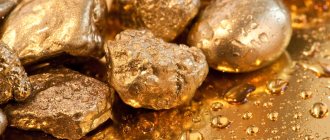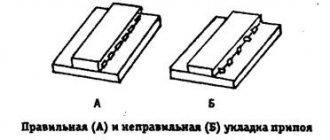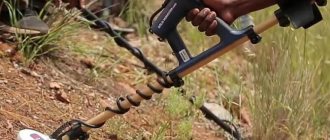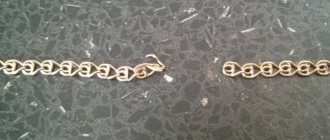Since ancient times, rivers, streams, waterfalls and beds of dry water streams have attracted gold seekers to their banks. Most prospectors are attracted by the opportunity to get rich quickly, but there are also those who are driven primarily by sporting interests. If a person is wondering how to find gold in a river and where to look for it, he should study the basics of geology, hydrology, collect all possible information about the search location and arm himself with the necessary equipment.
River gold as a secondary deposit. The concept of “alluvial deposits” and their types
As a result of continuous physical and chemical influences, primary rocks containing precious metals are destroyed. Constant temperature changes, precipitation, underground currents, all this contributes to inevitable changes. Gold separated from the rock begins its journey down the mountains, forming secondary or alluvial deposits.
River gold belongs to just such deposits. This precious metal is very heavy, so it accumulates where lighter elements are washed away by water.
River gold belongs to alluvial deposits, which are divided into three groups:
- terraced;
- bottom;
- oblique.
Alluvial placers are usually ribbon-shaped and longitudinal in relation to the direction of the valley.
River gold
Terrace placers are characteristic of mountainous areas and arise due to periodic incision of rivers. They are found both in deep streams and on dry arteries. A “terrace” is a bottom-island rising above the shore level.
Bottom placers are precious metal that has seeped through layers of rock to the bedrock bed.
Spit deposits need to be looked for on a river spit.
How can you tell if there is gold in a river or stream? Let's consider this issue in more detail.
How to wash - manual extraction technologies
To determine the presence of gold in rock, prospectors use traditional iron or plastic trays. It is preferable to use a plastic tool: it is lightweight and does not leave fingerprints on it. The optimal tray diameter is 20-40 cm. Additionally, a sieve with a cell size of 12 cm is purchased.
A sure sign of the presence of gold deposits is if at least one grain gets into the sieve. A negative result does not mean the absence of precious metal: you need to try again. Beginners still use pans to pan for gold, while experienced miners use mini-drags.
This device helps to significantly increase labor productivity. In terms of operation, it resembles a vacuum cleaner. Rock is pumped into the injector from the bottom of the river, which then enters a special chute. There, gold is separated from other solid elements by washing. Minidrags differ significantly in power and performance. Large devices are capable of processing a ton of material per hour.
Exploration, preparation and secrets of searching for gold: main stages
The search for prospectors is never complete without preparation and the further smile of fortune. There are certain instructions, following which the chances of finding a precious metal significantly increase.
Find a geologists' map and walk through the places where mining has already taken place
Where excavations have already been stopped, precious metal may remain. This is due to the fact that not all professional equipment is capable of extracting it completely from the ground. Therefore, trying your luck in such places often leads to a positive result.
Gold mining on the river
Explore the area and landscape
This point is key. Studying mineralogical maps before searching will make the task much easier.
Walking around the river valley with equipment
A regular metal detector will not “see” gold underwater. It zones the soil at a depth of 10 cm to 1 meter depending on thickness.
Unrefined metal contains a large number of impurities, which complicates the operation of the device. Gold miners are better off looking for places where the precious metal is located as close to the surface as possible. Shallow mountain rivers are ideal for searching.
Also, you should remember that the metal detector reacts equally to gold and iron.
Studying the bottom and bed of the river, its flow and pitfalls
The gold miner should determine the core of the river during the flood. This will immediately exclude places where there is no gold, since it was transported to another place by the flow of water.
Usually the precious metal lies at the very bottom of the river. If clay is discovered when opening the top layer, then this layer must be checked for the presence of metal. Clay may be false bedrock.
The flow rate will slow down significantly where the tributary flows into another river or lake. From this it follows that the beginning of the mouth will be the place of potential sedimentation of gold particles.
Yellow metal satellites
The minerals most often found in rock adjacent to the yellow metal are silver, quartz, galena, lead, and pyrite. The first is usually found with gold in some nuggets. The latter is especially often confused by beginners with the sought-after value due to the shine and yellow color it possesses.
I regret to say that even having found these signs of presence, one cannot be sure that the location of the noble metal is also here. But even unremarkable pieces of minerals should be checked for the presence of a yellow sheen, the hue and color of which does not change when light is refracted. It indicates the presence of Au inside. If you notice such shine - congratulations, you managed to find gold!
Licensing of mining activities from a gold mining company
On the territory of Russia, it is only possible to legally mine gold if you have an agreement with a licensed enterprise or under a personal license, but then the miner must be registered as an individual entrepreneur. In the second case, a person will be able to mine precious metal in a small free area for five years.
What kind of illegal mining will happen? What the law says
Gold mining by individuals is prohibited on the territory of our country. Violation is subject to administrative liability, a fine of 3 to 5 thousand rubles and confiscation of precious metals. Criminal liability arises only if particularly large-scale illegal production is proven.
Choosing a place to wash gold
Tips on how to choose the best place to extract the richest rock from the water and wash the yellow metal with the greatest benefit:
- Search on a river or in a stream from the list of the most “gold-bearing” ones, not far from the place of industrial mining - after it, not only the smallest grains of gold remain, but also whole nuggets, which are enough for everyone.
- Choose a section of the watercourse with a depth of more than 15 centimeters so as not to wash the metal in too dirty water full of small debris.
- Choose a section of the river with a relatively slow (slow) flow.
- If you're lucky, find a place with a large stone or a fallen tree where you can sit down so as not to wash the precious metal while standing.
TOP 10 Russian “gold-bearing” rivers
Experienced gold miners identify ten rivers where it is definitely worth looking for the precious metal:
- Lena River basin. At the end of the 19th century, about 30,000 workers worked here. Today the basin is still of interest to prospectors.
- River Bom. Gold is found in the river along its entire length.
- Millionny Brook. Rich placers of precious metal are found every year.
- Unaha River. Water flows connect to Unakha from the Uldehyde and Olongro tributaries, where placer deposits are located.
- Jalon Creek. Most of the metal has already been mined, but private miners regularly find gold here.
- Bodaibo River. It is distinguished by large alluvial solar metal.
- Big Chanchik River. Large nuggets are found here.
- Alekseevsky stream. In the waters of the stream there were gold finds weighing up to one kilogram.
- River Talga. Active gold mining has been going on since the 19th century.
- Sanarka River. Previously, gold mining in this area was carried out on an industrial scale.
It is also worth paying attention to many regions of Crimea, Bashkiria, Sochi, and Krasnodar Territory. The precious metal is found in rivers such as Belaya, Urup, Don, Oka, Kuban, Yaya, Sochinka, Tsna, Ai.
Gold appeared in the explosions of stars. But you can do it yourself
Unrefined gold nugget. Such people have been found, are being found, and will continue to be found.
The subsequent development of science, especially nuclear physics and materials science, forced scientists to think seriously: where do certain compounds and elements of the Periodic Table come from in nature?
Gold is present not only in deposits. It is dispersed throughout the planet, and is present in small proportions even in animals and people themselves.
According to some estimates, the ocean contains 20 million tons of gold dissolved in water, but in such low concentrations that the process of extracting it at this stage is too expensive.
It has long been assumed that gold was present in the original composition of the Earth before the formation of the earth's crust, and that the volcanic activity of the planet caused it to partially “rise” to the surface in the form of deposits.
Gold-bearing vein. Even primitive technology can extract metal from such a material.
This theory is partly explained by the presence of the element in post-igneous rocks. In addition, most primary deposits have large metal inclusions and are located in the form of gold-bearing veins.
However, large amounts of gold are dispersed in solid rocks in atomic form. In addition, planets are formed from gas and dust clouds and contain only some heavy elements in very small quantities.
As modern data show, to obtain gold, a nuclear reaction with high neutron radiation is necessary. This is the only way, through a long chain of transformations, to obtain radioactive gold.
A supernova was once considered the origin of gold
But the spectral lines of the Sun contain inclusions corresponding to gold. Therefore, it is there and could get to Earth with the solar wind.
If you didn't get there before. The solar wind would not provide an even distribution of the element. These contradictions and advances in astrophysics led to the emergence of a theory about the creation of gold during supernova explosions.
And only in 2013, scientists from the Harvard-Smithsonian Center for Astrophysics in Cambridge managed to detect traces of gold when analyzing a gamma-ray burst recorded at a distance of about 4 billion light years from Earth.
The gamma-ray burst was associated with the collision of two neutron stars and the subsequent explosion. It was this super explosion that gave birth to gold weighing several of our moons, as well as other heavy metals.
It was after such an event that gold came to us
Probably, a similar stream of particles visited the Earth about 540 million years ago and even earlier, leaving the first gold-bearing rocks.
Gradually, scattered atoms under the influence of geological processes formed modern gold veins, which all of humanity is familiar with from dozens of works describing the “gold rush”.
Three main ways to extract gold from a river
The following metal mining methods are the most common:
Minidrag - washing gold by hand
The dredge, like a big vacuum cleaner, pulls in rock from the bottom and filters it. Minidrags used by private miners are much smaller in size, but have a similar principle of operation. The main difference is that the process is controlled manually.
The productivity of such devices is high; they are capable of processing about 100 kg of rock in 60 minutes.
Gravity differentiation and rock crushing
The grinding of gold-bearing rock is called gravitational differentiation. The method is used in the development of primary deposits on an industrial scale. Private gold miners do not resort to differentiation.
Searches with a metal detector. Table: the most effective metal detectors for searching for gold in the river and at depth in the ground
A beginner in using a metal detector should first study the manufacturer’s literature and become familiar with all the parameters and characteristics of the model of interest. This will significantly improve work efficiency.
Searching for gold with a metal detector
For the first experience of using a metal detector, a familiar area near your home is suitable.
Metal detectors for searching for gold are either universal or specialized. The table below shows the best devices in terms of price and quality.
| Name | Characteristics | Price |
| Teknetics Eurotek PRO with 11 coil | It has all the functions that are usually found in devices of a higher class. There is a customizable discriminator that allows you to cut off unnecessary metal targets. The interface is intuitive. | RUB 22,350 |
| MINELAB X-TERRA 705 | The mechanism is professional, has several frequencies, and an error-free discrimination mode. | 37,000 rub. |
| Fisher F75 | A popular choice among professionals. It has a relatively light weight, high recoil speed, increased sensitivity to any targets, and an intuitive interface. | 57,000 rub. |
The listed devices can make searching for gold with a metal detector in streams profitable, fast, and extremely exciting.
The further fate of gold mining
Many scientists are struggling to find a new source for the precious metal because, according to some estimates, gold reserves will run out within half a century. One of the most promising methods is gold leaching.
A progressive method of mining from the bottom of the Bering Sea.
In addition to chemical methods, the development of the water element - the ocean - can help discover new deposits. Sea gold deposits are quite common, not to mention the ocean floor, about which little is known. It is likely that there, under water, there are rich reserves of the precious metal.
We also recommend that you read our article about the features of gold mining in Russia.
Category: question-answer
Is it possible to find a nugget in a stream?
Expert opinion
Shabanov Andrey
Amateur prospector, has been searching for gold for over 14 years
Yes, it's possible. Moreover, the stream itself may be nugget-like, then there will be very few grains of gold sand in it, but a lot of larger metal.
If I accidentally found a piece of gold in the river, does it belong to me? There is no license
Expert opinion
Grishanov Mikhail Petrovich
Jeweler, director of the Grishanov and Co. workshop
In this case, the gold find legally belongs to the state. By keeping it, a person will violate Article 191 of the Criminal Code of the Russian Federation. Do not try to take the metal to a buyer; this may result in criminal liability.
How can you mine Au?
To do this you will need the following equipment:
- The tray is better if it is blue: against this background, the yellow grains become especially noticeable.
- The gateway is the second stage of treatment from sand and other impurities, as it has special inserts on which heavier Au settles, and everything else is washed out.
- Tools – gold is mined in cracks using a pick or pick.
- Miniature gold dredge. Lightweight portable floating gold mining equipment. A budget option that makes it easier to search for aurum in rivers, it passes through up to 10 cubic meters of water per hour. With its help, panning for gold will be easier.
Ore processing
But this is not the whole process of gold mining, but only part of it. The next step: you need to extract the precious metal from the ore.
| Work performed | Result |
| First, large pieces of rock are crushed. | They shrink to the size of large grains of sand. |
| Then a cyanide solution is added and everything is mixed. | The result is a dirty, thick, liquid mixture. A cyanide solution in the presence of air liberates gold from the rock and trace metals. |
| As soon as the process is completed, the liquid is pumped out, and solid particles fall into a special tank. | There the reaction continues: the remaining cyanide solution isolates the rest of the gold. Heavy and large particles settle. |
| Zinc is added to the saturated solution, which releases the remaining gold from the mixture. | This process - called cyanide leaching - despite its high costs, is very profitable for gold mining companies. When used, up to 98% of gold is released from ore. |
For further purification, the metal is sent to a smelting furnace. Here gold is mixed with flux (a special chemical cocktail) and heated to one and a half thousand degrees. Result: approximately 80% cleansing of dirt and toxins. Further remelting makes the metal even purer.
Well, then it is used in medicine, microelectronics, aviation, astronautics and other industries. Bank bars of the famous gold standard are poured from it - 999 fine. It is extremely rare to use metal of this purity for jewelry because it is easily subject to deformation, which is impractical. In jewelry, the gold content is usually less than in bank bullion - due to additional metals (ligatures), which make the alloy more durable and even change its color.
There are fewer and fewer ores left in the world from which gold can be extracted using relatively simple methods. Perhaps only the gold-bearing conglomerates of South Africa allow such methods. In all other countries, the extraction of this metal is constantly becoming more complex and technologically advanced.
Placers
Gold placers in the Urals are located in areas located:
- near Magnitogorsk and Tagil;
- on the eastern part of the mountain range;
- in the central part of the Urals.
The upper reaches of the Suunduk River deserve special attention. It flows along the Ural mountains through the territory of the Orenburg region. At the same time, the upper layers of local placers have long been worked out. Currently, the development of layers that lie deep underground is underway.
Mostly alluvial placers are found here. They are formed due to the gradual transfer of rock mass, which includes gold veins. Such placers are often located in river valleys. In such deposits the gold is well rounded. That is, the metal is presented in the form of grains with clear edges.
Gold-bearing layers in the territory of the Ural placers are often concentrated in a certain zone. The maximum length of such deposits reaches 5 kilometers. Precious metal in local placers usually lies at a depth of 10 meters. There are also upper layers (1-3 meters) and deep layers (up to 60 meters).
The concentration of gold in placers varies. It varies from 0.01 to several milligrams in each cubic meter of mined ore material. Whole nuggets are also found in the Ural Mountains.
The attractiveness of local placers, from the point of view of private miners, is due to several factors. Firstly, there are more than one hundred of these deposits in the Urals. Secondly, they are formed by erosion of rock, due to which gold-bearing layers are formed on the river bottom. You can also look for metal in the area of the old riverbed. In other words, in the area where the river used to flow.
Placers in the Urals are a rich source of gold. Such deposits are found in various areas of the Siberian mountains, both close to populated areas and at a considerable distance from them.
